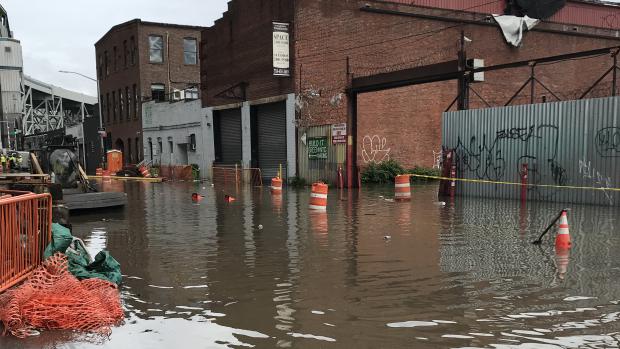A changing microbiome
A trio of NYU Tandon professors is studying the ramifications of urban flooding

A group of NYU Tandon researchers is studying how urban flooding changes the microbial community of urban surfaces with a focus on human health considerations, specifically determining how long sewage pathogens may stay viable after a flood event.
It might seem like the first chapter of a dystopian novel: climate change causes sea levels to rise. High-intensity storms pummel the city. Drainage systems are overwhelmed and sewage floods streets and homes, carrying with it an assortment of disease-causing bacteria and viruses.
Dystopian scenarios aside, of the myriad impacts predicted to accompany climate change, flooding is, in fact, expected to have an outsized influence on public health and infrastructure in urban areas. Urban flood water does, indeed, contain a diverse array of contaminants, including industrial and household chemicals, fuels, and pathogen-ridden sewage — all of which can be deposited on flooded surfaces, presenting exposure risks even after flood waters have receded.
A group of NYU Tandon researchers is now studying how urban flooding changes the microbial community of urban surfaces, investigating the ways in which the resulting microbial fingerprint evolves over time after a flood event, and determining how long it takes for the community to return to a pre-flood profile. With cities now home to more than half of the world’s population — an estimated four billion people — and that number only increasing, their research has enormous significance.
The three researchers — Assistant Professor of Civil and Urban Engineering Andrea Silverman, who has a joint appointment at NYU’s College of Global Public Health; Assistant Professor of Technology, Culture and Society Elizabeth Hénaff; and Assistant Industry Professor of Technology, Culture and Society Tega Brain — garnered a seed grant last year from NYU’s Marron Institute, which is dedicated to helping cities tackle the critical challenges facing them.
Although the researchers approach the topic from varying viewpoints, they each have deep experience with water systems and microbes. Hénaff, who holds degrees in computer science, plant biology, and bioinformatics, studies the ubiquitous and invisible microbial component of our environment, while Silverman, a recent recipient of a National Science Foundation CAREER Award, has focused on developing sustainable and appropriate wastewater treatment systems, including those using natural disinfection methods, and Brain is an environmental engineer who specializes in water-sensitive urban design. Researchers from Tandon's Center for Urban Science and Progress (CUSP) are also slated to participate, and this past summer, high school students from the NYU Tandon Center for K12 Education's ARISE (Applied Research Innovations in Science and Engineering) program pitched in.

The Marron grant-winning research, “The Impact of Flooding on the Urban Microbiome and City Residents’ Exposure to Sewage Pathogens,” is focused on the Gowanus neighborhood of Brooklyn, site of the Gowanus Canal; once a hub for manufacturing and shipping, the area became so heavily polluted that the Environmental Protection Agency designated the Canal a Superfund site in 2008.
The researchers explain that they are developing methodologies for monitoring, sampling, and analysis, thus establishing a set of standard operating procedures and pre-flood baseline data. They will then be prepared to rapidly deploy these methods after a flooding event and have benchmarks for comparison to post-flood data. They’re happy to be working in Gowanus. “We have established relationships with community organizations there and access to community-maintained and city-issued maps of known regular flooding locations,” they explain. “Furthermore, the site is near NYU Tandon so we can get there quickly after a flood. Most importantly, similar to the Gowanus neighborhood, many urban areas contain low-lying areas that are prone to flooding with a combination of stormwater and sewage, so we expect to gather broadly applicable data from our case study.”




